Hybrid cars have become increasingly popular over the past few years, thanks to their improved fuel efficiency and reduced emissions. There are several different types of hybrid cars available on the market today, each with its own unique features and benefits. From mild hybrids to plug-in hybrids, understanding the different types of hybrid cars can help you choose the right one for your needs and lifestyle. In this blog, we’ll explore the various types of hybrid cars and what sets them apart, so you can make an informed decision when it comes to buying your next car.

What are the different types of hybrid cars?
There are several different types of hybrid cars available on the market today, each with its own unique features and benefits. Here are the main types of hybrid cars:
- Full hybrid: Full hybrids are also known as parallel hybrids. They use both an electric motor and an internal combustion engine to power the vehicle. The electric motor is powered by a battery that is recharged through regenerative braking or the gasoline engine. The gasoline engine can also power the vehicle directly, giving the driver the option to switch between electric and gasoline power. Examples of full hybrid cars include the Toyota Prius and the Ford Fusion Hybrid.
- Mild hybrid: Mild hybrids are also known as parallel-assist hybrids. They use an electric motor to assist the gasoline engine, but the electric motor cannot power the vehicle independently. Instead, it provides additional power to the gasoline engine during acceleration and can help reduce fuel consumption by shutting off the engine when the car is stopped. Examples of mild hybrid cars include the Honda Insight and the Chevrolet Silverado.
- Plug-in hybrid: Plug-in hybrids, also known as PHEVs, are similar to full hybrids but with a larger battery that can be recharged by plugging the car into an external power source. This allows the car to run on electricity alone for a certain distance before the gasoline engine kicks in. Plug-in hybrids typically have a larger electric-only range than full hybrids, which makes them ideal for short commutes or city driving. Examples of plug-in hybrid cars include the Mitsubishi Outlander PHEV and the BMW i3.
- Range extender: Range extender hybrids use an electric motor to power the vehicle, but the gasoline engine acts as a generator to recharge the battery when it runs low. This means that the gasoline engine does not power the vehicle directly, but rather acts as a backup to extend the vehicle’s range. Examples of range extender cars include the BMW i3 REx and the Chevrolet Volt.
- Series hybrid: Series hybrids use an electric motor to power the vehicle, but the gasoline engine only serves to recharge the battery and does not directly power the vehicle. In a series hybrid, the gasoline engine acts as a generator, providing electricity to the electric motor when the battery runs low. Examples of series hybrid cars include the Fisker Karma and the Chevrolet Volt (first generation).
Understanding the different types of hybrid cars can help you choose the right one for your needs and lifestyle. By considering factors such as driving habits, fuel economy, and charging options, you can select a hybrid car that meets your needs and helps you save money on fuel costs while reducing your impact on the environment.

Some examples for the different types of hybrid cars
- Full hybrid: Toyota Prius, Lexus CT 200h, Ford Fusion Hybrid
- Mild hybrid: Honda Insight, Kia Niro Hybrid, Hyundai Ioniq Hybrid
- Plug-in hybrid: Mitsubishi Outlander PHEV, BMW i3, Chevrolet Volt
- Range extender: BMW i3 REx, Vauxhall Ampera, Karma Revero
- Series hybrid: Fisker Karma, Chevrolet Volt (first-generation), BMW i3 (with optional range-extender)

Conclusion
In conclusion, hybrid cars come in different types that offer varying levels of electric motor assistance and gasoline engine power. Full hybrids use both electric and gasoline power sources, while mild hybrids have a smaller electric motor that provides extra power to the gasoline engine. Plug-in hybrids have larger batteries that can be charged through an external power source and can run solely on electricity for a certain distance before the gasoline engine kicks in. Range extenders use an electric motor to power the car, but a gasoline engine serves as a generator to recharge the battery when it runs low. Finally, series hybrids use an electric motor to power the vehicle, and the gasoline engine acts as a generator to recharge the battery. Each type of hybrid car has its own advantages and disadvantages, and it’s important to consider which one fits your needs before making a purchase.
